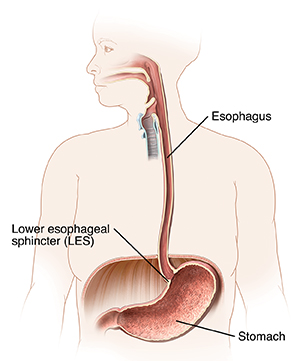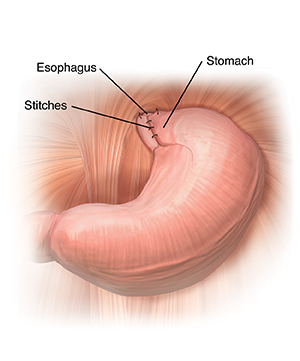Surgery for GERD (Fundoplication)
You have gastroesophageal reflux disease (GERD). This health problem causes food and fluid to flow back (reflux) into your esophagus. Other treatments have not helped. Your healthcare provider is now advising a surgery called fundoplication. This surgery is used most often when GERD causes complications or side effects. It’s also used for people who don’t handle medicines well. People who respond best to this surgery are those who did well using acid blocker medicines first. Read on to learn more.
What the surgery does
The lower esophageal sphincter (LES) is a muscular ring that opens and closes at the top of the stomach. It keeps food and fluid from flowing backward. Your LES is weak. It does not correctly open and close off the top of your stomach. This means that food and fluid can flow back into your esophagus from your stomach. During fundoplication, the LES is restructured. This is done by wrapping the very top of the stomach around the lower part of the esophagus.

 |
| The top of the stomach is wrapped around the esophagus. The wrap is permanently stitched in place. |
Two types of surgery
The surgery is most often done with laparoscopy. But it may also be done with open surgery.
Laparoscopy. This surgery uses a few small cuts (incisions). A thin, lighted tube called a laparoscope is used. This scope lets the healthcare provider see inside your body and work through the small incisions.
Open surgery. This surgery uses a single large incision. The healthcare provider does the repair through this incision. This method may be used if your healthcare provider feels it isn’t safe to continue with laparoscopic surgery.
During the surgery
An IV (intravenous) line is put into a vein in your arm or hand. This IV line gives you fluids and medicines. You are then given medicine (anesthesia) so that you don’t feel pain during surgery. Most often, general anesthesia is used. It lets you sleep during the surgery. Here are the general steps once surgery starts.
For laparoscopy:
-
The healthcare provider makes 2 to 5 small incisions in your belly area (abdomen). The scope is put through one of the incisions. The scope sends live pictures to a video screen. This lets the healthcare provider see inside your belly.
-
Tiny surgical tools are placed through the other small incisions.
-
Your belly is filled with carbon dioxide. This gas provides space for the healthcare provider to see and work.
For open surgery:
-
One large incision is made.
-
The esophagus travels through an opening in the diaphragm called the hiatus. You have a hiatal hernia if your stomach has pulled up into the chest area. If this is the case, the hiatus is tightened with a few stitches.
-
The stomach is wrapped around the outside of the esophagus. The wrap is stitched into place.
-
When the surgery is done, all tools are removed. Any incisions are closed with stitches (sutures) or staples.
Risks and possible complications
-
Injury to the liver, spleen, esophagus, or stomach
-
Infection
-
Increased gas or bloating
-
Bleeding
-
Not able to vomit
-
Trouble swallowing
-
Not able to get rid of GERD
-
Need to take medicines again for GERD